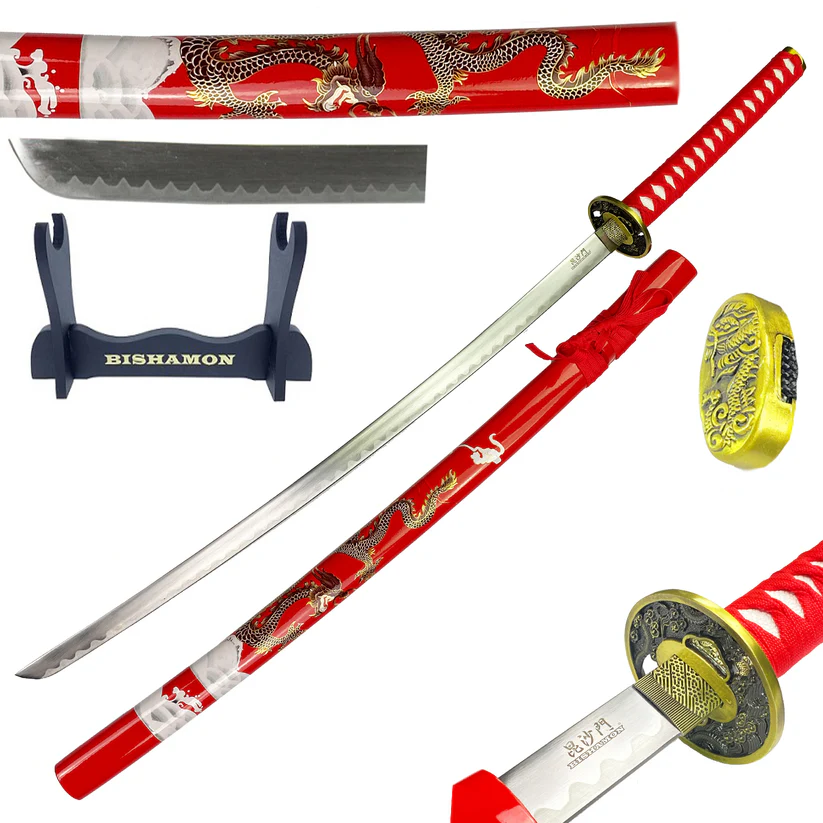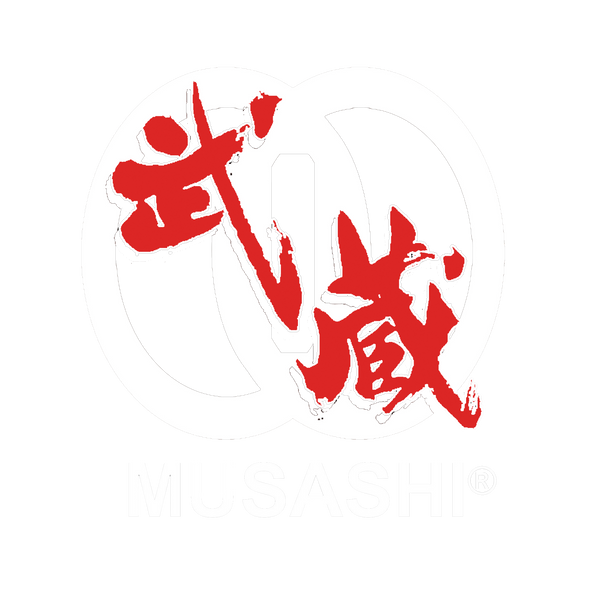
Samurai Sword Buying Guide: Beyond the Katana
Share
Japanese swords come in many types besides the katana - you’ll find the shorter wakizashi, small tanto knife, and the classic tachi sword. Real Japanese swords, called nihonto, must be checked carefully. Look for the wavy pattern on the blade, real maker signatures, and high-grade T10 steel. Before buying, check the sword’s quality, papers, and your local laws about owning one. When you know these basics, you can spot and buy real Japanese swords with confidence.
Key Takeaways
- Look beyond katanas to consider wakizashi and tanto blades, which offer different historical significance and practical applications.
- Verify authentic nihonto swords through proper documentation, maker’s marks (mei), and genuine hamon patterns.
- Choose quality materials like T10 tool steel and avoid suspiciously cheap swords claiming traditional folded construction.
- Research local sword ownership laws and registration requirements before making any purchase.
- Evaluate blade craftsmanship through surface patterns, proper shape, and authentic signatures matching historical context.
Types of Japanese Swords: Understanding the Family Tree
Japanese swords come in many types, each with its own role and history. The katana is the best-known type, with a curved blade that’s about 23 to 33 inches long and has one sharp edge.
Next is the wakizashi, a shorter sword between 12 and 24 inches, which pairs with the katana to make what’s called a daisho set. The tanto is the smallest of the main types, like a dagger that’s 6 to 12 inches long.
Other kinds of swords developed for different uses. The tachi is worn with its edge pointing down and has a longer blade than most. The o-katana was made for specific fighting needs.
Today, many students learn sword arts using iaito, which are practice swords without sharp edges, helping them learn safely. During World War II, the military made gunto swords by machine, moving away from the old ways of hand-making swords.
Essential Terminology for Sword Collectors
Japanese sword collecting relies on knowing the right words to properly judge and talk about different swords. A Nihonto is a real Japanese sword made the old way, which sets it apart from copies or swords made in other countries.
When looking at swords to buy, collectors check if it’s a shinken - a real working sword - instead of one made just for practice. The hamon, a wavy line on the blade that comes from heating and cooling the metal, helps show if a sword is real and how skilled the maker was.
Other important parts include the mei - the maker’s name and details carved into the blade - and how the steel is put together. A sword can be maru, made from one piece of steel, or built from different layers, which changes how well it works and tells us about its history.
Evaluating Blade Quality and Craftsmanship
A good samurai sword starts with the right steel.
The best blades are made from T10 tool steel, which stays sharp and won’t break easily - exactly what a real Japanese sword needs. You can spot great craftsmanship by looking at three main things: the wavy line along the blade created by special heating methods, the correct blade shape following old Japanese styles, and clear patterns in the steel’s surface from careful forging.
A maker’s signature carved into the blade helps prove it’s genuine and shows who made it.
Each of these features adds to how well the sword works and how beautiful it looks.
Anatomy of Traditional Japanese Sword Fittings
Japanese swords have many carefully made parts that work together to make the sword both useful and beautiful.
The tsuba acts as a guard to protect the hand and often shows detailed artwork, like scenes of goddesses and dragons made from copper. Special decorations called fuchigashira and menuki are made from strong copper and decorated with silver and gold.
The handle is wrapped with either black silk for Muramasa swords or white rayskin for O-Katanas, which helps the user hold the sword firmly.
At the end of the handle is the kashira, which matches the other sword parts and sometimes has gold designs painted on it.
The saya, which holds and protects the blade, can be decorated with shiny shell pieces and painted designs to make the sword look even more special.
Authentication Markers and Red Flags
When checking if Japanese swords are real, buyers need to look for several important signs.
The signature carved into the sword’s base should show clean cuts and natural aging that matches when and who made it. Real swords also have special wavy lines along the blade, called hamon, which come from special heating methods that fake swords can’t copy well. Watch out for warning signs like swords sold as old pieces without proper papers or expert approval.
Be careful with cheap swords under $300 that claim to be folded many times during making - especially those saying more than 16 folds. Good sellers always show proper papers proving their swords are real and have positive reviews from sword experts backing up their work.
Legal Considerations and Ownership Requirements
Before buying a katana, you need to know the laws in your area, as rules differ from place to place. Each region has its own set of rules about owning swords, including getting permits, registering weapons, and following rules about blade size and type.
Since some places treat katanas as dangerous weapons, you must check your local laws carefully. You can find helpful information about sword ownership rules online or through local authorities. Breaking these laws can get you in serious trouble, with fines or having your sword taken away.
To stay on the right side of the law, make sure you understand all the rules about buying and owning katanas. Look up both your country’s laws and any special rules in your city or state.
Maintenance and Preservation Techniques
A katana needs regular care to stay in good shape, focusing on cleaning, storage, and expert checks. The blade needs careful oiling and cleaning with special cloths. Keeping the sword in a room with steady heat and moisture levels helps protect it.
|
Maintenance Element |
Frequency |
Technique |
|
Blade Cleaning |
After each use |
Soft cloth wipe |
|
Oil Application |
Monthly |
Thin sword oil coat |
|
Storage Position |
Continuous |
Sharp edge upward |
|
Ito/Rayskin Check |
Quarterly |
Visual inspection |
|
Saya Maintenance |
Annually |
Professional restoration |
Taking care of a katana means looking after both how it works and how it looks, from keeping the edge sharp to protecting the sheath’s surface. For any major fixes, skilled workers should do the repairs to keep the sword real and strong.
Trusted Sources and Price Range Guidelines
When buying a real Japanese sword, you need to be sure about who you’re buying from and how much you should spend. Good swords usually cost between $779.99 and $917.99, especially those made from T10 tool steel.
The best places to buy are well-known online stores that give you proper papers, clear details about the sword, and real feedback from buyers.
Be careful with swords that cost less than $300 - they often don’t have real hamon (temper lines) or proper craftsmanship, even if sellers claim they do.
Remember to plan for extra costs if you want to change things like the handle wrapping or scabbard design.
To avoid buying fake swords, check sword expert reviews and join sword forums. This is especially important when buying from places like eBay, where it’s harder to tell if a sword is real.
Frequently Asked Questions
Is There a Sword Better Than the Katana?
Many swords, such as the European longsword and Chinese dao, can match or beat the katana in different fighting situations. While each sword has its own strengths in battle, their true value goes beyond just how well they cut or thrust.
What to Look for When Buying a Samurai Sword?
To find a good samurai sword, check the blade’s quality and how well it’s made. Look for strong materials like T10 steel and real wave patterns on the blade. Make sure the sword feels balanced when you hold it. Buy only from trusted sellers who can prove the sword is real.
Is It Legal to Buy Samurai Swords?
Laws about owning samurai swords differ from place to place. Each country and region has its own rules about bringing these swords in and who can own them. While many places respect these swords as important cultural items, anyone wanting to buy one needs to check their local laws first. They should also learn how to take care of these special weapons properly.
How Much Does a Real Samurai Sword Cost?
Real samurai swords usually cost between $780 and $918. The price depends on how well they’re made and what they’re made from. For sword collectors, special and rare pieces can cost over $500, and some rare ones can sell for thousands of dollars.
Conclusion
The acquisition of authentic Samurai Swords requires good knowledge of metalwork, historical crafting, and legal rules. Collectors should check blade shape, hamon patterns, and sword parts while making sure all papers and history are real. Through careful research, proper checking, and following preservation steps, collectors can make smart choices in these historic weapons. Visit Musashi Swords today to explore our collection of authentic Japanese blades.
